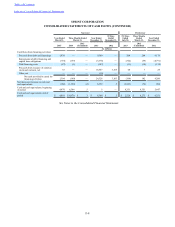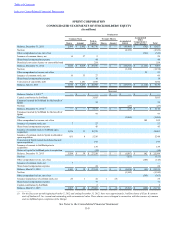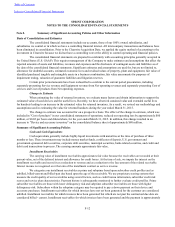Sprint - Nextel 2014 Annual Report Download - page 99
Download and view the complete annual report
Please find page 99 of the 2014 Sprint - Nextel annual report below. You can navigate through the pages in the report by either clicking on the pages listed below, or by using the keyword search tool below to find specific information within the annual report.
Table of Contents
Index to Consolidated Financial Statements
SPRINT CORPORATION
NOTES TO THE CONSOLIDATED FINANCIAL STATEMENTS
F-16
on the next 2% of eligible compensation up to a maximum matching contribution of 4%. For the Predecessor year ended
December 31, 2012, the Company matched 50% of participants' contributions up to 2% of their eligible compensation. Fixed
matching contributions totaled approximately $71 million, $15 million and $35 million for the Successor year ended
March 31, 2015, the three-month transition period ended March 31, 2014 and year ended December 31, 2013, respectively,
and $32 million, $15 million, and $30 million for the Predecessor 191-day period ended July 10, 2013, unaudited three-
month period ended March 31, 2013, and year ended December 31, 2012, respectively. Prior to 2013, the Company also
made a discretionary matching contribution, as determined by the Board of Directors of the Company, equal to 100% of
participants' contributions up to 3.95% of eligible compensation, or $60 million, in the Predecessor year ended December 31,
2012 based upon the attainment of certain profitability levels.
Revenue Recognition
Operating revenues primarily consist of wireless service revenues, revenues generated from device and accessory
sales, revenues from leasing a device, revenues from wholesale operators and third-party affiliates, as well as long distance
voice, data and Internet revenues. Service revenues consist of fixed monthly recurring charges, variable usage charges and
miscellaneous fees such as activation fees, directory assistance, roaming, equipment protection, late payment and early
termination charges, interest, and certain regulatory related fees, net of service credits and other adjustments. We generally
recognize service revenues as services are rendered, assuming all other revenue recognition criteria are met. We recognize
revenue for access charges and other services charged at fixed amounts ratably over the service period, net of credits and
adjustments for service discounts, billing disputes and fraud or unauthorized usage. As a result of the cutoff times of our
multiple billing cycles each month, we are required to estimate the amount of subscriber revenues earned but not billed from
the end of each billing cycle to the end of each reporting period. These estimates are based primarily on rate plans in effect
and our historical usage and billing patterns. Regulatory fees and costs are recorded gross. The largest component of the
regulatory fees is the universal service fund, which represented no more than 2% of net operating revenues for all periods
presented in the consolidated statements of operations.
We recognize equipment revenue and corresponding costs of devices when title and risk of loss passes to the
indirect dealer or end-use subscriber. For arrangements involving multiple deliverables such as equipment and service,
revenue is allocated to the deliverables based on their relative selling prices. Equipment revenue is limited to the amount of
non-contingent consideration received when the device is sold to a subscriber. Equipment revenue is also reduced by the
estimated amount of imputed interest associated with installment receivables for subscribers who elect to finance the
purchase of a device for up to a 24-month period. Often, we subsidize the cost of the device as an incentive to retain and
acquire subscribers. The cost of these incentives is recorded as a reduction to revenue upon activation of the device and a
service contract.
Qualified subscribers can lease a device for a contractual period of time. At the end of the lease term, subscribers
have the option to turn in their devices, continue leasing their device or purchase the device. Accounting for device leases
involves specific determinations under applicable lease accounting standards, which involve complex and prescriptive
provisions. These provisions impact the timing and amount of revenue recognized for our leased devices. The critical
elements that are considered with respect to our lease accounting are the economic life of the device and the fair value of the
device, including the residual value. We only lease devices to qualifying subscribers that also purchase a service plan. To
date, substantially all of our device leases were classified as operating leases. Revenues under these arrangements are
allocated considering the relative fair values of the lease and non-lease elements included in the multiple-element
arrangement. The amount of the arrangement consideration allocated to the operating lease element is recognized ratably over
the lease term, which is typically two years.
If a multiple-element arrangement includes an option to purchase, on a monthly basis, an annual trade-in right, the
amount of the total arrangement consideration is reduced by the estimated fair value of the trade-in right or the guarantee and
the remaining proceeds are then allocated amongst the other deliverables in the arrangement.
The accounting estimates related to the recognition of revenue require us to make assumptions about numerous
factors such as future billing adjustments for disputes with subscribers, unauthorized usage, future returns, mail-in rebates on
device sales, the fair value of a trade-in right and the total arrangement consideration.
























